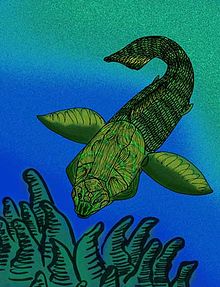
Dunkleosteus is an extinct genus of large arthrodire ("jointed-neck") fish that existed during the Late Devonian period, about 382–358 million years ago. It was a pelagic fish inhabiting open waters, and one of the first apex predators of any ecosystem.

Groenlandaspis is an extinct genus of arthrodire from the Late Devonian. Fossils of the different species are found in late Devonian strata in all continents except eastern Asia. The generic name commemorates the fact that the first specimens of the type species were found in Greenland.

Rhenanida is an order of scaly placoderms. Unlike most other placoderms, the rhenanids' armor was made up of a mosaic of unfused scales and tubercles. The patterns and components of this "mosaic" correspond to the plates of armor in other, more advanced placoderms, suggesting that the ancestral placoderm had armor made of unfused components, as well.
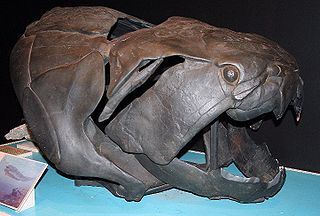
Dunkleosteidae is an extinct family of arthrodire placoderms that lived during the Devonian period. The gigantic apex predator Dunkleosteus terrelli is the best known member of this group.
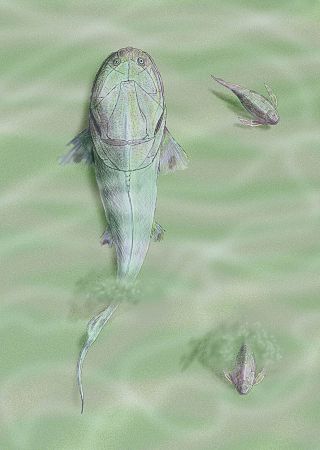
Homosteus is a genus of flattened arthrodire placoderm from the Middle Devonian. Fossils are found primarily in Eifelian-epoch aged strata of Europe, Canada, Greenland, and Estonia. All of the species had comparatively large, flattened heads with, as suggested by the upward opening orbits, upward-pointing eyes. These adaptations suggest that the various species were benthic predators. A study on Titanichthys, in contrast, suggests that species of Homosteus may have been filter-feeders instead.

Holonema is an extinct genus of relatively large, barrel-shaped arthrodire placoderms that were found in oceans throughout the world from the Mid to Late Devonian, when the last species perished in the Frasnian-Fammian extinction event. Most species of the genus are known from fragments of their armor, but the Gogo Reef species, H. westolli, is known from whole, articulated specimens.
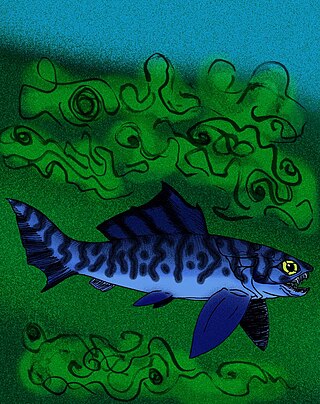
Hadrosteus is an extinct monospecific genus of large arthrodire placoderm from the Late Frasnian Kellwasserkalk facies of Bad Wildungen, Germany. It had large, double-pronged inferognathals, and serrated edges along its mandible, strongly suggesting that it was a fish-eating predator. The head had a triangular snout, and the trunkshield was short, but high, with a median dorsal plate that was broader than wide. The average skull length is about 16 centimeters.

Pachyosteus is an extinct monospecific genus of medium-sized selenosteid arthrodire placoderm known from the Upper Frasnian Kellwasserkalk facies of Late Devonian Bad Wildungen, Germany and from the Famennian portions of the Holy Cross Mountains of Poland. The type species Pachyosteus bulla has a broad skull about 7 to 10 centimetres long, a comparatively long median dorsal plate, and a short rostral plate that meets the pineal plate.

Belemnacanthus giganteus is a large, extinct, barrel-shaped holonematid arthrodire placoderm from Givetian-aged strata of Middle Devonian Eifel, Germany. B. giganteus is known only from the holotype, a 37 centimetres (15 in) portion of a median dorsal plate with a long, somewhat high, arching crest running down the median line of the exterior/dorsal side of the plate. The plate has an ornamentation of ridges that originate from a point posterior to the preserved portion of the median dorsal plate. Before the plate was identified as that of a holonematid, the plate of B. giganteus had been successively described as a tremendous spine of an elasmobranch, an agnathan, and lastly, the plate of an antiarch.

Rhenonema eifeliense is a large, extinct, high-crested holonematid arthrodire placoderm from Givetian-aged strata of Middle Devonian Gerolstein, Germany. It is known from some fragments of armor, including an anterior-lateral plate estimated to be around 24 centimetres (9.4 in) long, and a portion of a median dorsal plate with a very tall crest running along the median line of the dorsal surface. The ornamentation is very similar to that of Holonema, but the concentrically arranged ridges are much coarser in Rhenonema. The holotype was originally described by Kayser, in 1880, as a species of Dinichthys, but was then redescribed in 1964 by Obruchev as a holonematid.

Tropidosteus curvatus is a large, extinct holonematid arthrodire placoderm from the Givetian-aged Crinoidenmergel stratum of Middle Devonian Rheinland, Germany. T. curvatus is known from primarily from a slender, 42 centimeter long, arched median dorsal plate, where the two sides meet at a sixty to ninety degree angle, which would have given the live animal a humped appearance. The median dorsal plate is very similar to the median dorsal plates of Rhenonema and Belemnacanthus, and is the primary reason for T. curvatus' placement within Holonematidae. After stating this reason, Denison, 1978, then questions Tropidosteus' placement within the family, noting that the dorsal plate lacks ridged ornamentation, which is a key diagnostic trait of the family. The ornamentation otherwise consists of an external covering of small tubercles.

Homostiidae is a family of flattened arthrodire placoderms from the Early to Middle Devonian. Fossils appear in various strata in Europe, Russia, Morocco, Australia, Canada and Greenland.
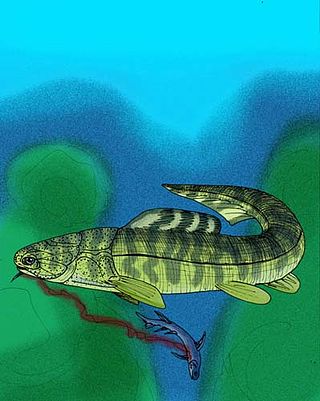
Buchanosteidae is a family of arthrodire placoderms that lived from the Early to Middle Devonian. Fossils appear in various strata in Russia, Central Asia, Australia, and China.

Aspidichthys is a genus of large, distinctively tuberculated arthrodire placoderm of uncertain affinities from Upper Devonian marine strata in the Eastern United States and Europe.

Angarichthys hyperboreus is an extinct homostiid arthrodire placoderm from the Middle Devonian of Siberia. It is known from an infragnathal plate, an intero-lateral plate, and a marginal plate found from the Middle Devonian strata of the Tynep Series formation, in the Bakhta River basin, Tunguska Plateau. A. hyperboreus differs from Homosteus in that the former's marginal plate has a ridge where the central plate would have overlapped it, and in the infragnathal, which is curved sigmoidally, and bears at least seven tooth-like prongs nearer to the functional anterior end.
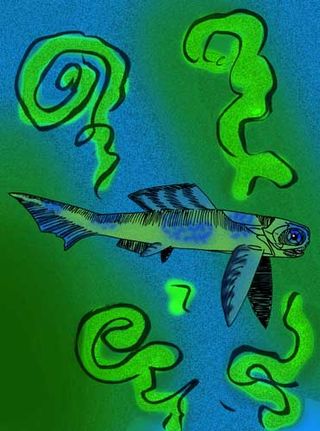
Walterosteus is an extinct genus of small selenosteid arthrodire placoderms known from the Upper Frasnian Kellwasserkalk facies of Late Devonian Germany and Morocco.

Brachydeiridae is a family of small to moderately large-sized arthrodire placoderms from the Late Devonian of Europe, restricted primarily to the Kellwasserkalk Fauna of Bad Wildungen and Adorf.

Brachydeirus is a genus of small to moderately large-sized arthrodire placoderms from the Late Devonian of Europe, restricted to the Kellwasserkalk Fauna of Bad Wildungen and Adorf.

Oxyosteus is a genus of trout-sized, highly compressed arthrodire placoderms from the Late Devonian of Europe: The two described species are restricted to the Late Frasnian-aged Kellwasserkalk Fauna of Bad Wildungen, while a median dorsal plate of an unnamed species is known from the Middle Frasnian Holy Cross Mountains of Poland.
Microbrachius is an extinct genus of tiny, advanced antiarch placoderms closely related to the bothriolepids. Specimens range in age from the Lower Devonian Late Emsian Stage to the Middle Devonian Upper Givetian Stage. They are characterized by having large heads with short thoracic armor of an average length of 2–4 cm. There are patterns of small, but noticeable tubercles on the armor, with the arrangement varying from species to species. Specimens of Microbrachius have been found in Scotland, Belarus, Estonia, and China.
